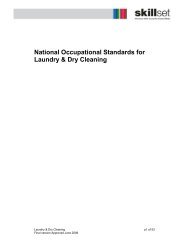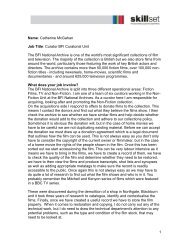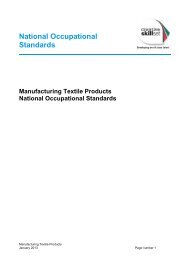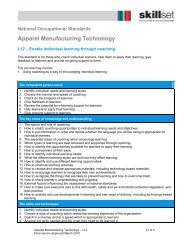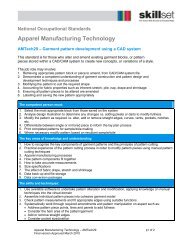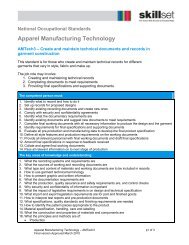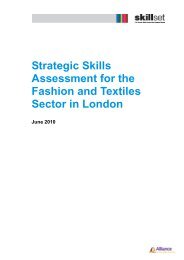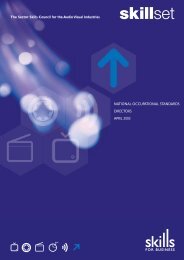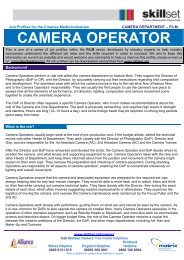National Occupational Standards - Lighting for Film and ... - Skillset
National Occupational Standards - Lighting for Film and ... - Skillset
National Occupational Standards - Lighting for Film and ... - Skillset
Create successful ePaper yourself
Turn your PDF publications into a flip-book with our unique Google optimized e-Paper software.
NATIONAL OCCUPATIONAL STANDARDS<br />
LIGHTING FOR FILM & TELEVISION<br />
JUNE 2006<br />
L17 OVERSEE THE HEALTH AND<br />
SAFETY OF LIGHTING CREWS<br />
UNIT OVERVIEW<br />
This Unit is about overseeing the health <strong>and</strong> safety of<br />
lighting crew during a production on location. It is about<br />
con<strong>for</strong>ming with current legislation <strong>for</strong> production<br />
administration, organisation, planning <strong>and</strong> ongoing risk<br />
assessment in order to maintain a safe <strong>and</strong> healthy<br />
working environment.<br />
It requires communicating effectively with other<br />
colleagues about work activity <strong>and</strong> with the team about<br />
the procedures <strong>and</strong> other work occurring at the work<br />
location.<br />
KNOWLEDGE AND UNDERSTANDING<br />
this is what you must know<br />
a) what your health, safety, welfare <strong>and</strong> employment<br />
responsibilities <strong>and</strong> liabilities are <strong>and</strong> the<br />
importance of ensuring that other people are kept<br />
in<strong>for</strong>med<br />
b) the importance of appointing first aiders <strong>and</strong><br />
ensuring that you <strong>and</strong> your crew are aware who<br />
these personnel are<br />
c) the purpose <strong>and</strong> importance of risk assessments<br />
<strong>and</strong> that these are continually implemented within<br />
your team.<br />
d) organisational procedures <strong>and</strong> requirements<br />
relevant to:<br />
• the electrical risk assessment<br />
• The production risk assessment<br />
• ensuring sufficient quantities <strong>and</strong> availability<br />
of personal, protective equipment, safety<br />
equipment <strong>and</strong> resources<br />
• welfare facilities<br />
• reporting an accident <strong>and</strong> or near misses<br />
e) the importance of having statutory notices <strong>and</strong><br />
hazard warnings <strong>and</strong> where to place them <strong>for</strong> best<br />
effect <strong>and</strong> <strong>for</strong> having systems to assist with the<br />
identification <strong>and</strong> rectification of hazards.<br />
f) the principles <strong>and</strong> methods of hazard identification<br />
<strong>and</strong> classification methods<br />
g) the importance of keeping everyone fully in<strong>for</strong>med<br />
about what to do <strong>and</strong> when in the context of<br />
health <strong>and</strong> safety <strong>and</strong> their responsibilities with<br />
regard to their work<br />
h) awareness of disciplinary procedures <strong>and</strong> other<br />
sanctions in relation to non-compliance of health<br />
<strong>and</strong> safety procedures<br />
SKILLSET JUNE 2006<br />
49



